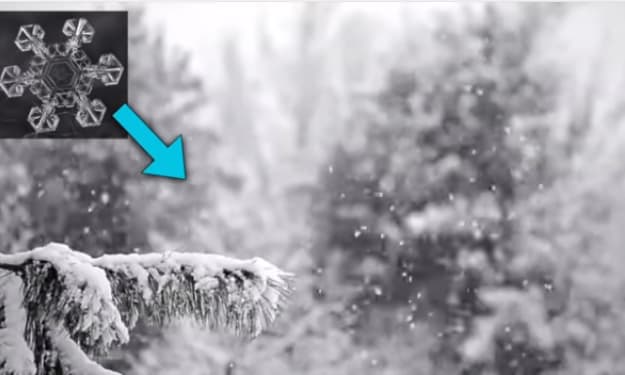Can Trees Talk to Each Other
What's the oldest Tree in the World

If trees could talk to each other,
certainly trees like these bristlecone pines
would have a lot of interesting stories to tell.
But trees can't talk to each other in any way that we talk.
They don't have a mouth or hands
or any of the body parts humans use to talk.
Still, what if we broaden the word talk
to mean just communicate
or send any kind of message to each other?
Can trees do that?
Well, if you'd asked me, I would've said,
"I really don't think so."
But recently I noticed this group of trees.
As I stared at these,
I noticed something really interesting.
I'm curious what you notice.
What I notice is that there's a little bit of space
between each treetop,
almost as if these trees can send messages or communicate
to keep from getting in each other's way.
Now, maybe that's just the way that they grew,
because that's the way that got the most amount of sunlight
for each tree.
But it makes me wonder,
could trees actually work together like this?
And if they did work together,
wouldn't they have to share information to do that?
Like maybe send messages to each other?
A scientist named Suzanne Simard
has thought a lot about these questions.
Suzanne Simard studies trees,
but not just any part of the tree.
You see, when she was younger,
Suzanne played a lot in a forest near her home.
She used to love to lie on her back
and watch the tops of the trees
waving around in the wind high above her.
Then one day, she saw something in the forest
that changed how she saw it forever.
She saw a hole in the ground.
That's it, just an ordinary hole,
nothing special about it.
But when young Suzanne looked down into the hole,
what she saw blew her away.
It wasn't just dirt down there.
There was so much life poking through the soil
under the surface,
from wiggling worms to crawling bugs to tangling roots.
That was the moment Suzanne Simard realized
there's a whole world under the trees as well,
every bit as detailed and interesting as the world above.
As an adult now, her research focuses
on understanding everything that's going on below the soil
at of the roots of the trees in the forest.
As she explored the underground forest world,
Suzanne Simard started paying attention
to tiny living things in the soil called fungi.
You might have seen some parts of fungi called mushrooms
above the ground before,
but there's a whole other world of fungi below the surface.
These fungi form chains underground.
They look like long strings.
Suzanne Simard noticed that these fungi strings
don't just grow in random spots.
They grow between the roots of trees,
connecting the forest in a huge underground fungi web.
Suzanne Simard wondered, "What can trees do
with all these underground connections?
Can they use them to share things or even communicate?"
She set up an experiment to answer her question.
She gave one tree in a forest a very specific nutrient.
She waited an hour,
then checked to see if that nutrient showed up
in any other trees in the forest,
and, holy cow, it did.
The special nutrients Suzanne Simard gave the tree
traveled down the tree's roots
through the fungi web into the roots of another tree.
These two trees weren't touching at all,
but they could still share nutrients
because their roots were connected by strings of fungi.
Now, this isn't exactly trees talking,
but you might think of it as a kind of communication.
Trees linked by underground fungi can share what they have
the same way you might swap a snack with a friend.
And Suzanne Simard thinks trees
might share more than just nutrients through the fungi web.
She thinks trees might actually use these connections
to send messages to each other.
Suzanne Simard and another scientist named Yuan Yuan Song
did an experiment on injured trees.
When they studied a tree injured by bugs,
they noticed the tree was producing an unusual chemical.
That chemical traveled from the roots of the sick tree
through the fungi web to a nearby healthy tree.
Then the healthy tree started doing something amazing.
It made a sticky substance to defend against bugs.
It's a daring idea,
but Suzanne Simard argues
that we might think of the chemical the sick tree sent
as a message, a warning signal to other trees saying,
"Hey! Watch out!
There are dangerous bugs around here."
The nearby tree got the message
and started protecting itself.
So can trees talk to each other?
Well, they don't communicate in words,
but some scientists think forests
can share nutrients and warnings
with the help of a huge web of underground fungi.
Still, not everyone is convinced yet.
Some scientists think we don't know enough
to say that trees can even communicate at all.
We have lots to discover
about what's really going on in forests,
but one thing is clear.
There's so much more going on in a forest
than what we see above ground.
Maybe you'll be the next scientist to add
to what we know about the complicated lives trees live
right under our feet.
Hope you enjoyed this. Thanks for your support so far. Really appreciate.
About the Creator
samuel olakehinde
BSc Agricultural Engineering. Music tutor, Article writer, Musician, Song Writer. Livestock Specialist.
Enjoyed the story? Support the Creator.
Subscribe for free to receive all their stories in your feed. You could also pledge your support or give them a one-off tip, letting them know you appreciate their work.






Comments
There are no comments for this story
Be the first to respond and start the conversation.